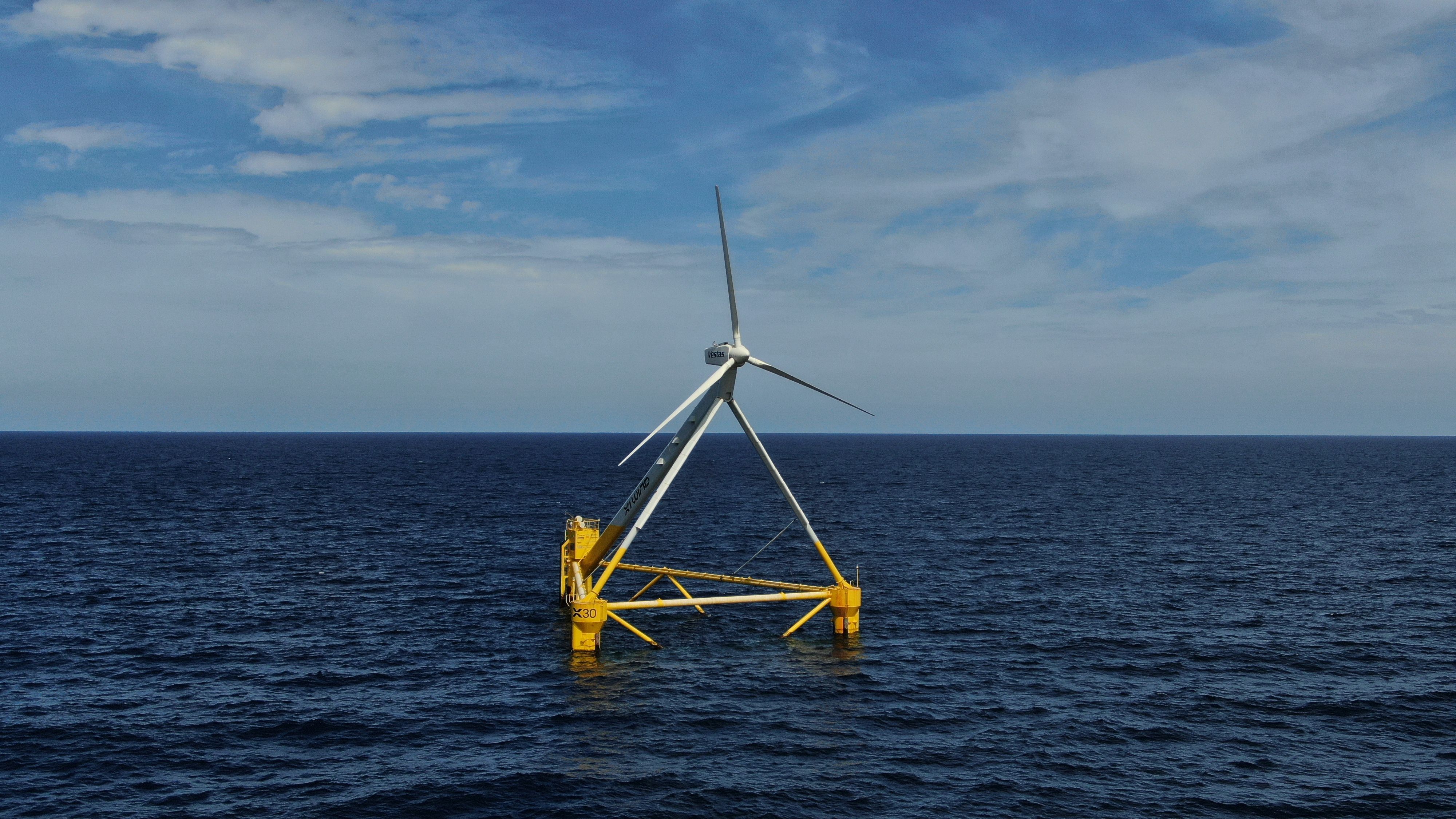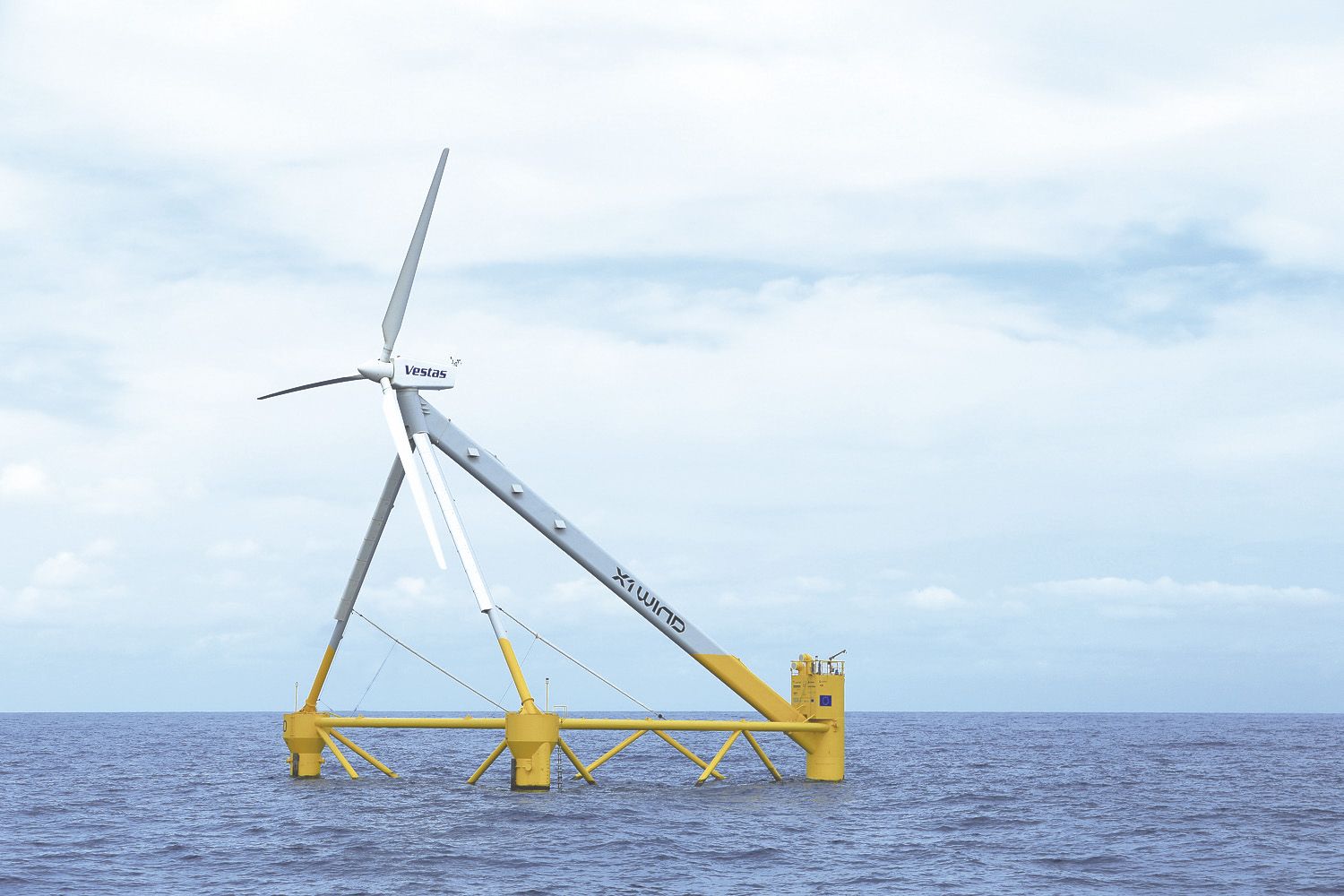Description
X1 Wind developed an innovative floating wind platform that significantly reduces capital expenditures (CAPEX) and the Levelised Cost Of Energy (LCOE).
The PivotBuoy floating platform presents a hybrid concept between a semi-submersible floater and a tension-leg mooring system.
The tripod-like upper structure and the downwind turbine allow a more efficient load configuration in which the main masts are tensioned, and the side masts are compressed, avoiding the high bending moments that make design complex in traditional concepts. In addition, by having a single point mooring, the platform can weathervane and passively remain aligned with the wind direction during its operation, without the need for active yaw systems. The TLP is also the optimal solution for deployment in very deep waters and is coupled with a patented quick connector that significantly simplifies the installation processes.
The combination of all these systems brings some unique advantages to the design. It optimizes the platform loads and uses slender tubular elements, which result in an expressive reduction of the global steel weight. Adding to the lighter structure, the proprietary quick connection system, developed in-house by the company’s mechanical engineering experts, allows simplified and quicker installation and maintenance processes, which can be easily performed by smaller vessels available in local ports. Furthermore, the design eliminates the need for active mechanisms such as yaw and ballast, and includes a proprietary SCADA monitoring system, making the operation of the platform reliable and efficient. Lastly, the TLP mooring has an outstandingly small seabed occupation when compared to the traditional catenary systems, improving the compatibility of the windfarm with other sea uses, such as fisheries, research, or biodiversity protection, as well as allowing more platform units in the same maritime zone.
The installation procedure comprises the pre-installation of the mooring system and the later quick connection of the platform, using small to medium vessels for transportation and hook-up procedures. This makes offshore operations simpler, reduces possible constraints of the fleet, and lowers the installation costs.
The PivotBuoy Technology has been proven through the PivotBuoy Project, which consisted of the design, fabrication, and testing of the X30 part-scale floater (1:3) in the Canary Islands, Spain. The X30 floating wind platform became the world’s first fully functional floating wind platform installed with a TLP mooring system and Spain’s first floating wind prototype to export electricity via a subsea cable.
Overview
- The X30 prototype was the world’s first fully functional TLP floating wind platform to export power.
- Spain’s first floating wind prototype to export electricity via a subsea cable.
- Data obtained about platform self-alignment, roll and pitch, and power curve show excellent results and provided critical insights that are now being transferred to our Commercial-scale Projects.

Description
The PivotBuoy Project included the design, fabrication and testing of the X30 floater in the Canary Islands, Spain. This was X1 Wind’s first floating platform deployed in open ocean waters. It consisted of a part-scale prototype (1:3 scale compared to the X90) that integrated the PivotBuoy® mooring system, a Vestas V29 turbine adapted for a downwind configuration, and all the required control systems. The Project was funded by the European Commission H2020 Program, with the target of substantially reducing the Levelized Cost of Energy (LCOE) of floating wind. The consortium, led by X1 Wind, brought together a combination of experienced industrial partners – EDP New, DNV, INTECSEA, ESM and DEGIMA – and cutting-edge R&D centres – PLOCAN, DTU and WavEC.
The X30 prototype was the world’s first fully functional TLP floating wind platform to export power and Spain’s first floating wind prototype to export electricity via a subsea cable.
The Project demonstrated the PivotBuoy innovative mooring system configuration that combines the advantages of a SPM (single point mooring) with a small TLP (Tension-Leg Platform) mooring system, allowing the platform to reach deeper waters and minimizing the footprint and impact on the seabed. Additional features of the platform include the light-weight and stable floater, which can be easily wet towed by local vessels thus simplifying and accelerating the installation process.
This Project started 1st of April 2019, and after the design phase, the manufacturing was completed in November 2020 by DEGIMA in Santander, despite the challenges brought by the COVID-19 pandemic. The platform was shipped in 9 different parts to Las Palmas, Canary Islands, to facilitate the transportation and handling operations. The portside assembly and load-out were successfully carried out in Hidramar, a shipyard with over 25 years of experience in the Oil&Gas industry and the Naval sector.
The portside testing of subsystems, installation of foundations and dynamic cable was done before mid-2022, with the final offshore installation done in October 2022 at a 50m water depth. The PivotBuoy Project has been a significant venture in the world of renewable energy. In fact, the X30 prototype was the world’s first fully functional TLP floating wind platform to export power and Spain’s first floating wind prototype to export electricity via a subsea cable.
The 1:3 scale prototype platform was operating in PLOCAN until the end of May of 2023, when it was decomissioned. In fact, the decommissioning process, which was a requirement after the end of the EU funded project in March 2023, also proved the ease of disconnection of its innovative single point mooring system, successfully completing the disconnection, unhook and towing in less than one working day.
This marked another milestone for the industry, especially taking into account that it was used a TLP mooring system. While offering many advantages, it was historically very difficult to hook and un-hook. Therefore, by proving that the PivotBuoy® mooring system can be easily hooked and unhooked, it has been shown that TLPs can easily be installed, decommissioned or maintained at port in case a tow-to-port maintenance operation is needed.
The X30 platform was towed to Arinaga Port for its full decommissioning, removing the key elements for further analysis. and offering some parts to the Instituto Técnológico de Canarias (ITC) for educational purposes at its facilities in Pozo Izquierdo.
Data obtained about platform self-alignment, roll and pitch, and power curve show excellent results and provided critical insights that are now being transferred to our Commercial-scale Projects.
The most striking result is that data showed very good alignment with the wind using its passive orientation system. The platform showed better alignment than publicly available data for traditional active yaw systems for strong winds (>7.5m/s) and similar alignment for lower wind speeds (<7.5m/s).
In terms of power production, energy generated by the modified Vestas V29 – which operates in a downwind configuration – was well aligned with theoretical models, with no sign of power loss or increased 3P vibration due to the tripod shadow. The results confirm that X1 Wind’s streamlined tripod arrangement eliminates the known drawbacks typically associated with downwind operation.
In addition, the platform overcame several harsh storms, with maximum wave heights reaching 6.7 meters, equivalent to more than 20 meters in full-scale. During these extreme events, the unit behaved well with motions and accelerations matching the predictions in simulation models.
X1 Wind, as the PivotBuoy Porject Coordinatior, has been recognized worldwide do to the singular innovation of the PivotBuoy Technology, which contribute to the acceleration of offshore wind by dramatically decreasing floating wind LOCE.
X1 Wind’s PivotBuoy Project accomplishments have been acknowledged across continents. In Europe, we proudly received the “Premio Eolo de Innovación 2023” from the Asociación Empresarial Eólica (AEE) at the Congreso Eólico Español. Across Asia, we clinched the “Smart Technology Innovation of the Year” accolade at the prestigious Wind Future Awards held by the Asean Wind Energy 2024. Last but not least, in the United States, our PivotBuoy Project stood as a finalist in the esteemed “Innovation of the Year” category for the Ventus Awards 2023. These acknowledgments stand as validations of our innovative technology’s cost-effectiveness and its impact in reducing the Levelized Cost of Energy for floating offshore wind solutions.



)
)
)

)
)
)
)
)
)
)